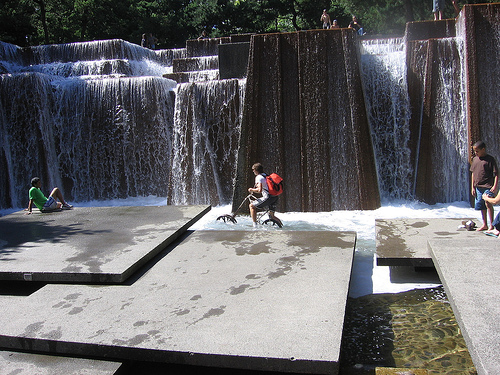So, while Wall Street Giants shuddered, pivoted and crashed to the ground, Art Scatter was amusing itself at “City Dance,” the celebration of Lawrence and Anna Halprin, specifically Lawrence’s Portland plazas and fountains, Anna’s dances and early ’60s San Francisco art music, which somehow affected both. I will type (or is it keyboard, technically?) as long as I can, until the shock wave takes us off line… oddly it seems appropriate to muse on subjects such as these during times of economic crisis.
 We’ve already set up the fountains, and to a lesser extent the dances, in a post below. To summarize, L. Halprin was hired by Ira Keller and the PDC to provide some public spaces for Portland’s first major Urban Renewal project, the demolition of the South Auditorium district and its replacement by a Skidmore, Owings, Merrill office/residential park. Keller was so happy with these, that he later asked L. Halprin to finish off the set with a plaza/fountain in front of what was then Civic Auditorium. It’s now the Keller Auditorium and the fountain is now Keller Fountain, though old-timers will be excused for calling it the Forecourt Fountain.
We’ve already set up the fountains, and to a lesser extent the dances, in a post below. To summarize, L. Halprin was hired by Ira Keller and the PDC to provide some public spaces for Portland’s first major Urban Renewal project, the demolition of the South Auditorium district and its replacement by a Skidmore, Owings, Merrill office/residential park. Keller was so happy with these, that he later asked L. Halprin to finish off the set with a plaza/fountain in front of what was then Civic Auditorium. It’s now the Keller Auditorium and the fountain is now Keller Fountain, though old-timers will be excused for calling it the Forecourt Fountain.
Fast forward 40 years or so. The fountains and plazas, important icons in the history of urban landscape design, could use a little conservation work, and so architecture writer/magazine editor Randy Gragg, the Halprin Conservancy, Third Angle New Music Ensemble and four Portland choreographers (Tere Mathern, Cydney Wilks, Linda Austin and Linda K. Johnson) banded together to help raise our collective consciousness about the Halprins’ work by staging a moving concert through all four sites (Keller Fountain, Pettygrove Park, Lovejoy Fountain, Source Fountain).
So on Sunday afternoon, sunny and warm, several hundred Portlanders, unaware perhaps that financial Redwoods were crashing, assembled to watch the show on the last day of the Time-Based Art Festival. Maybe there were more than that, adding the two concerts together. The second concert was so packed that when I arrived right before it began, I couldn’t get close enough to see anything much at the first site, the Keller Fountain, but that’s not going to deter me from my posting. Because there were three more sites to visit.
Continue reading Sunday in the park with the Halprins (while Rome burned)
